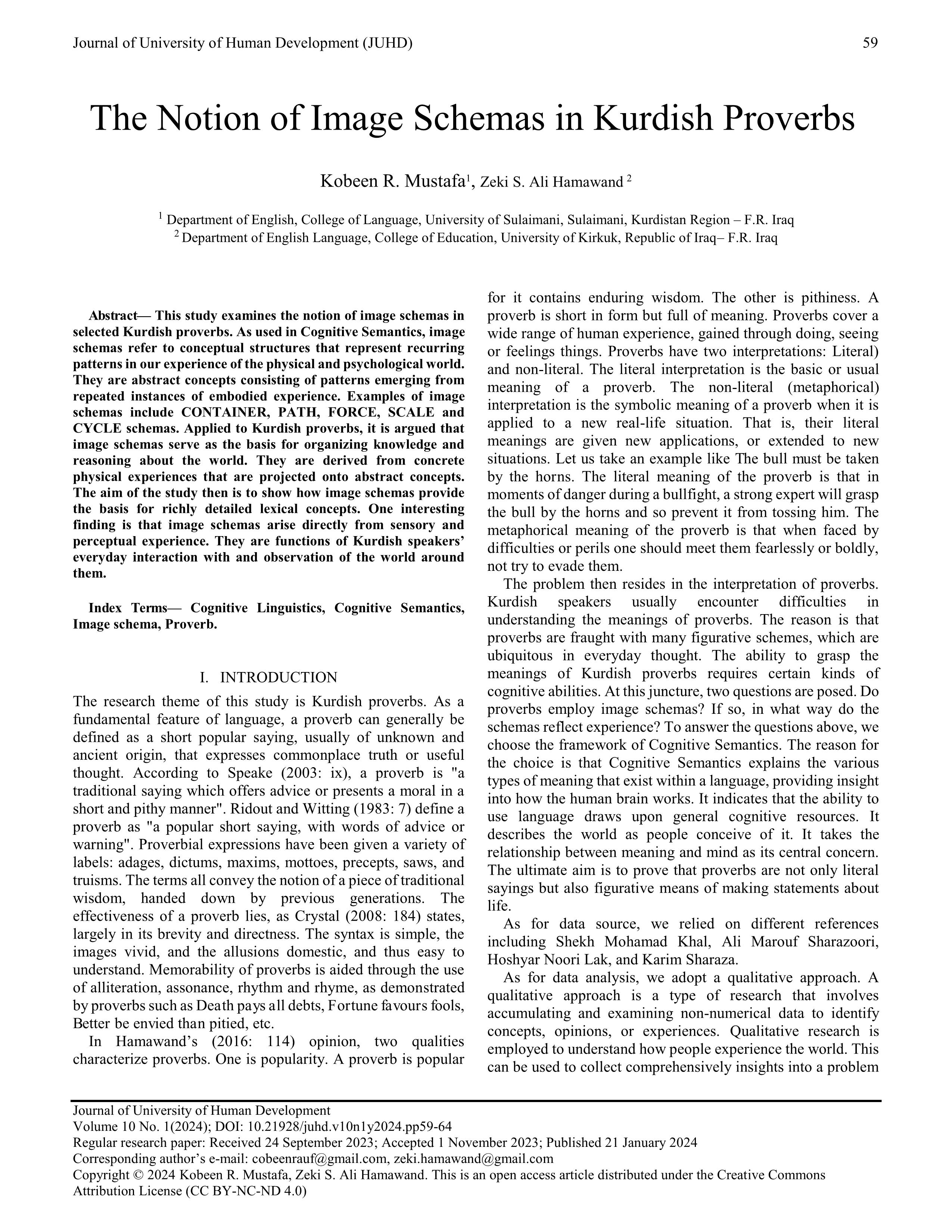The Notion of Image Schemas in Kurdish Proverbs
DOI:
https://doi.org/10.21928/juhd.v10n1y2024.pp59-64Keywords:
Cognitive Linguistics, Cognitive Semantics, Image schema, ProverbAbstract
This study examines the notion of image schemas in selected Kurdish proverbs. As used in Cognitive Semantics, image schemas refer to conceptual structures that represent recurring patterns in our experience of the physical and psychological world. They are abstract concepts consisting of patterns emerging from repeated instances of embodied experience. Examples of image schemas include CONTAINER, PATH, FORCE, SCALE and CYCLE schemas. Applied to Kurdish proverbs, it is argued that image schemas serve as the basis for organizing knowledge and reasoning about the world. They are derived from concrete physical experiences that are projected onto abstract concepts. The aim of the study then is to show how image schemas provide the basis for richly detailed lexical concepts. One interesting finding is that image schemas arise directly from sensory and perceptual experience. They are functions of Kurdish speakers’ everyday interaction with and observation of the world around them.
References
English references
Croft, Willam. and Alan Cruse. (2004) Cognitive Linguistics. Cambridge: Cambridge University Press.
Cruse, Alan. (2006). A glossary of semantics and pragmatics. Edinburg: Edinburgh UP.
Crystal, David (2008) A Dictionary of Linguistics and Phonetics. Malden, MA: Wiley-Blackwell (an imprint of John Wiley & Sons Ltd).
Evans, Vyvyan. (2007). A glossary of cognitive linguistics. Edinburgh: Edinburgh University Press Ltd.
Evans, Vyvyan, & Melanie Green. (2006). Cognitive linguistics: An introduction. Edinburgh: Edinburgh University press
Hamawand, Zeki. (2008) Morpho-Lexical Alternation in Noun Formation. London: Palgrave.
Hamawand, Zeki. (2016) Semantics: A Cognitive Account of Linguistic Meaning. London: Equinox Publishing Limited.
Hamawand, Zeki. (2023) English Stylistics: A Cognitive Grammar Approach. London: Palgrave.
Johnson, Mark. (1987). The body in the mind. The bodily basis of meaning, Imagination and reason. Chicago: Chicago University Press.
Lakoff, George. (1987) Women, fire, and dangerous things: What categories reveal about the mind. University of Chicago Press.
Lakoff, George. (1993) The contemporary theory of metaphor. In A. Ortony (Ed.), Metaphor and thought (pp. 202–251). Cambridge University Press.
Lakoff, George and Mark Johnson. (1980) Metaphors we live by. Chicago: The University of Chicago Press.
Langacker, Ronald. (1991) Concept, Image, and Symbol: The cognitive Basis of Grammar. Berlin, Germany: Mouton de Gruyter.
Murphy, Lynne and Anu Koskela (2010) Key terms in semantics. Bloomsbury Publishing.
Oakley, Todd. (2012) Image schemas. In Dirk Geeraerts and Hubert Cuyckens (eds.) The Oxford Handbook of Cognitive Linguistics. Pages: 214–235.
Ridout, Ronald and Clifford Witting. (1983) English Proverbs Explained. Pen-Books.
Speake, Jennifer. (2003) The Oxford Dictionary of Proverbs. Oxford: Oxford University Press.
Taylor, John. (2002) Cognitive grammar. Oxford: Oxford University Press.
Kurdish references
Khal , Sheikh Mohamad (2007) پەندی پێشینان Proverb. Bakhtiary book shop.
Sharazoori, Ali Marouf (2010) پەندی پێشینانی کورد Kurd proverb. Sheikh Razai Talabani
book shop.
Lak, Hoshyar Noori (2011) گولبژێرێک لە پەندی کوردی A collection of Kurdish proverb.
Bakhtiary book shop.
Sharaza, Kerim (1983 ) پەندی بەراوردکاری لە نێوان ئینگلیزی. عەرەبی. کوردی Comparative proverbs between English, Arabic and Kurdish. Samir Amis printing house

Downloads
Published
How to Cite
Issue
Section
License
Copyright (c) 2024 Kobeen R. Mustafa, Zeki S. Ali Hamawand

This work is licensed under a Creative Commons Attribution-NonCommercial-NoDerivatives 4.0 International License.


